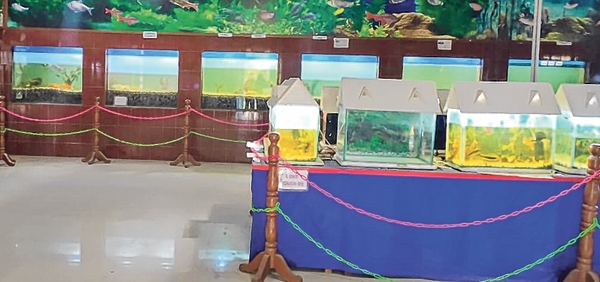Nganap vanishes from markets, survives in aquarium only as ornamental fish
|

By Our Staff Reporter
IMPHAL, Feb 5 : The presence of Nganap, which is associated with many tales and beliefs of Meetei society has dwindled so much that the fish variety is no longer seen in markets today, let alone make a dish out of it.
If anyone, specially the younger folks want to see how the fish variety, which is served to bride and groom belonging to Meetei community on their marriage day almost as a compulsion in the past, looks like, then they may head to Manipur Science Aquarium (MSA) opened at Dhanamanjuri University (DMU).
MSA is currently rearing five Nganaps at the moment.
The Sangai Express went on an inspection tour to MSA to have a first hand knowledge on how different types of indigenous fish varieties are being kept there for conservation purposes.
The science aquarium was opened on March 31, 2011 under Manipur Science and Technology Council with the primary objective of conserving indigenous fish varieties of Manipur.
Nganap is closely associated with the history of Manipur as people believe that serving the fish variety to couples on their marriage day makes them live longer and prosperous.
In the not so distant past, Nganap used to be a common dish with its unique flavour but the scenario has changed so fast in the past few years that the fish variety has become a very rare sight, said the aquarium's Scientific Officer RK Pritamjit.
Though not extinct, Nganap is becoming an endangered fish species as they can no longer be found in the markets today, he added.
Speaking to this reporter, RK Pritamjit continued that the science aquarium is rearing five Nganaps with utmost care to let people understand how the fish looks.
Saying that the lifespan of Nganap is eight to ten years, he added that the science aquarium used to rear more Nganaps in its initial stage.
Further stating that the Nganaps they now have were donated to the aquarium by a person from Tera, Pritamjit maintained that many people, specially students come to the aquarium frequently to see indigenous fish varieties.
He went on to state that Nganap is listed among the expensive fish varieties in Manipur.
"We visit markets frequently to see if there are any people who rear Nganap," he added. Continuing that the functioning of the science aquarium is being managed by three staff as one staff retired recently under the funding of Manipur Science and Technology Council, Pritamjit stated that the fund provided by the State to hold exhibition and buy feed for the fishes is limited.
"We attended office even during the peak of Covid pandemic to feed the fishes as they are very rare and their conservation is imperative," Pritamjit maintained and added that many students and people visited the aquarium during the pandemic.
Not many people come to the aquarium these days, he narrated and added that they charge Rs 10 per head to enter the science aquarium and money collected is used to buy feed for the fishes from Kolkata and Guwahati.
Local feed is also given to the fishes occasionally, Pritamjit continued.
There were instances when the door of the aquarium was found broken as there is no chowkidar, he said and appealed to all to understand the rarity of the fishes they rear and help in conserving them.
The aquarium has 28 big fish tanks and 28 small tanks and is rearing many varieties of fishes such as Ngaton, Tunghanbi, turtle, Phabounga and import fishes such as rainbow shark and many others, he informed and said that all the equipment and materials were bought from Kolkata.

